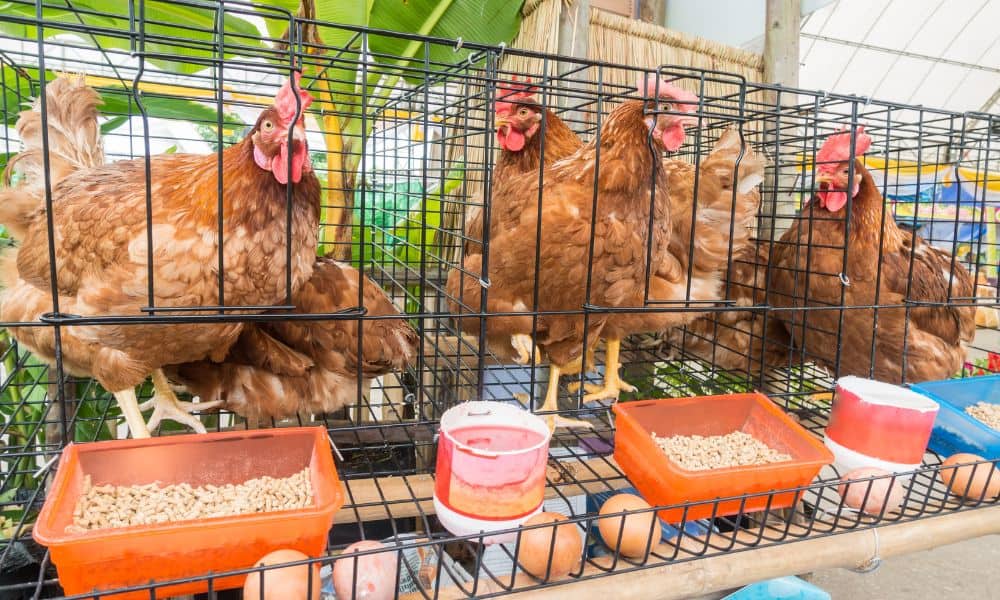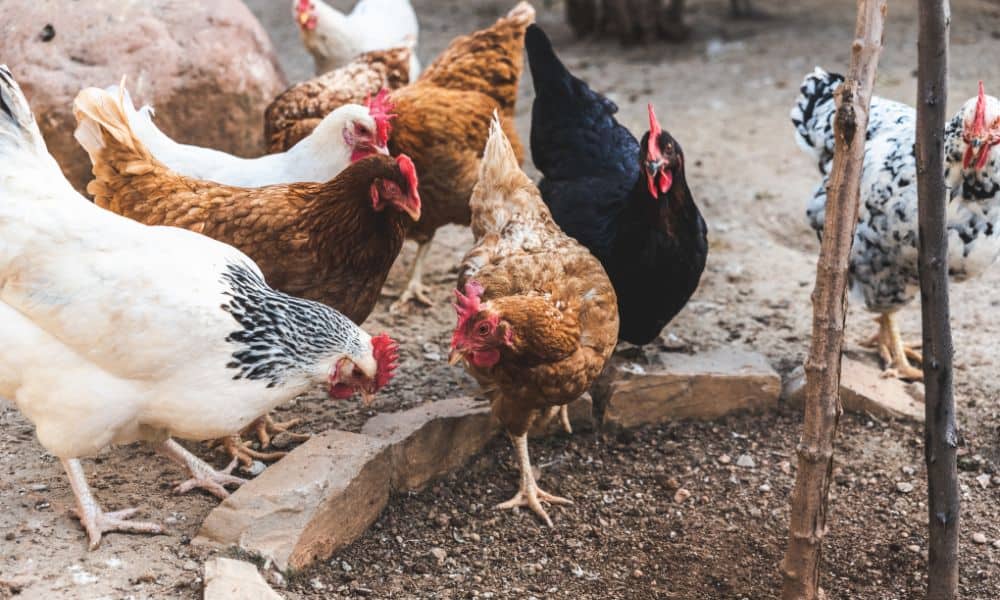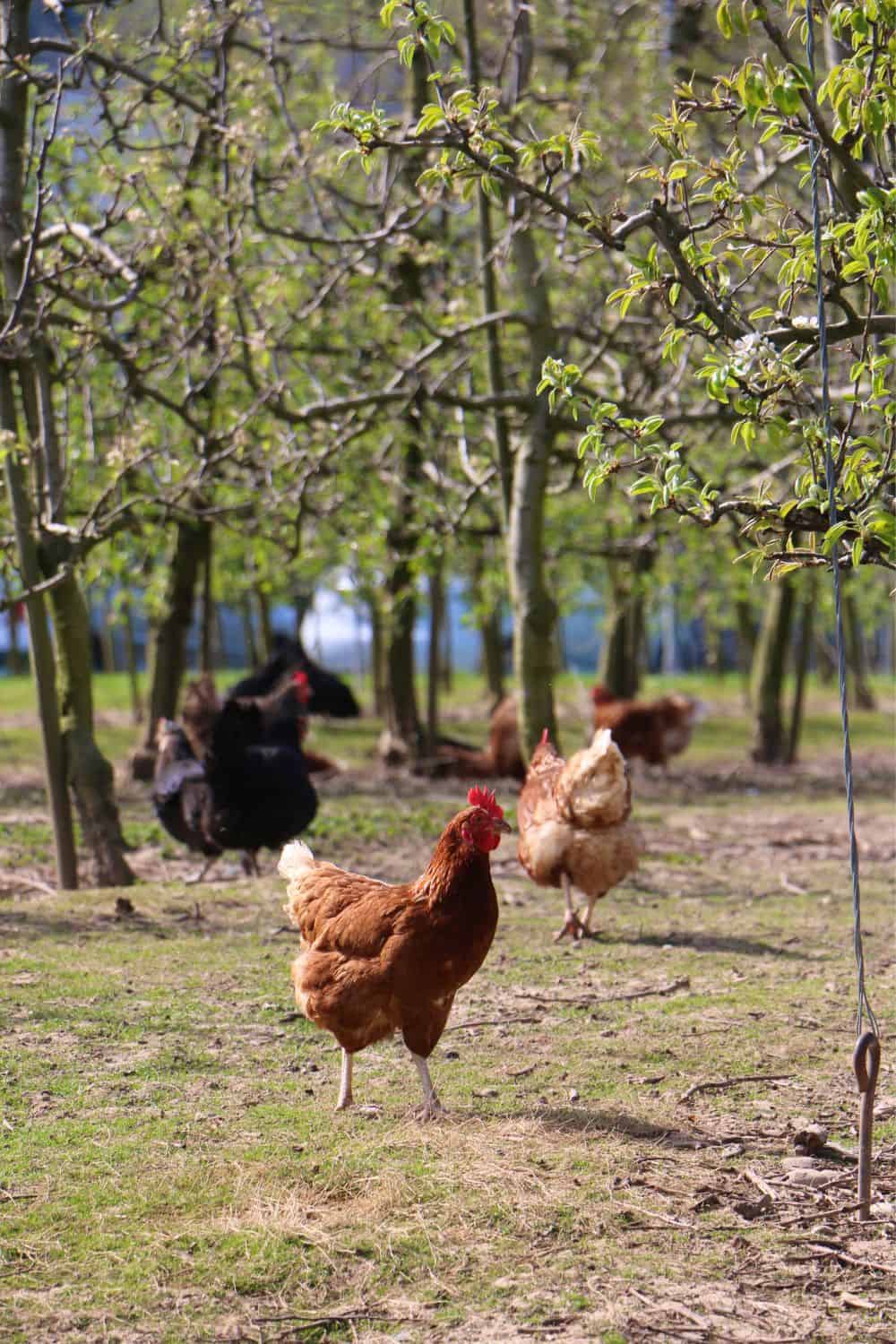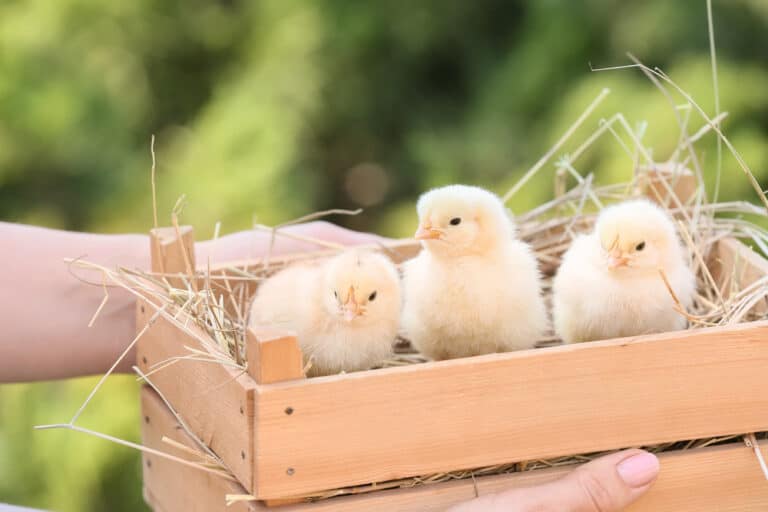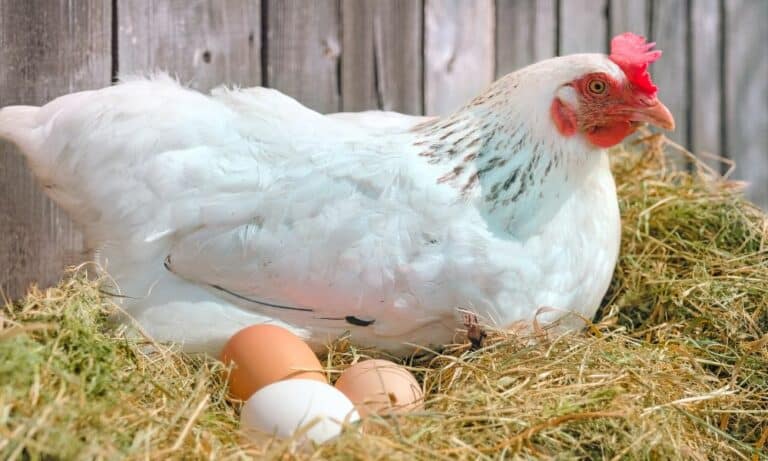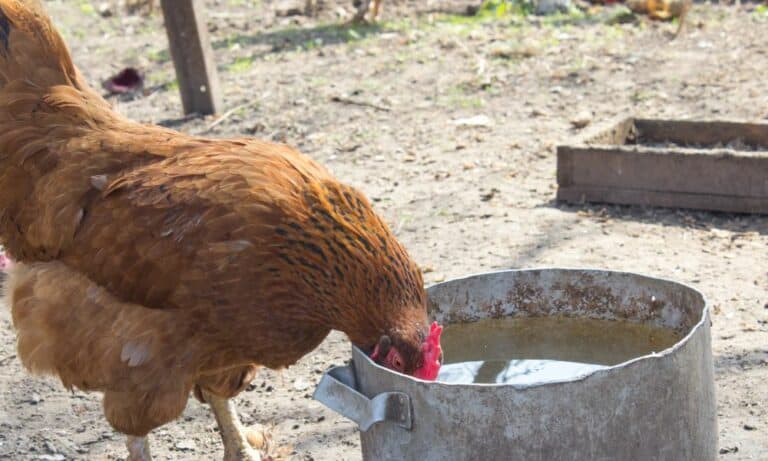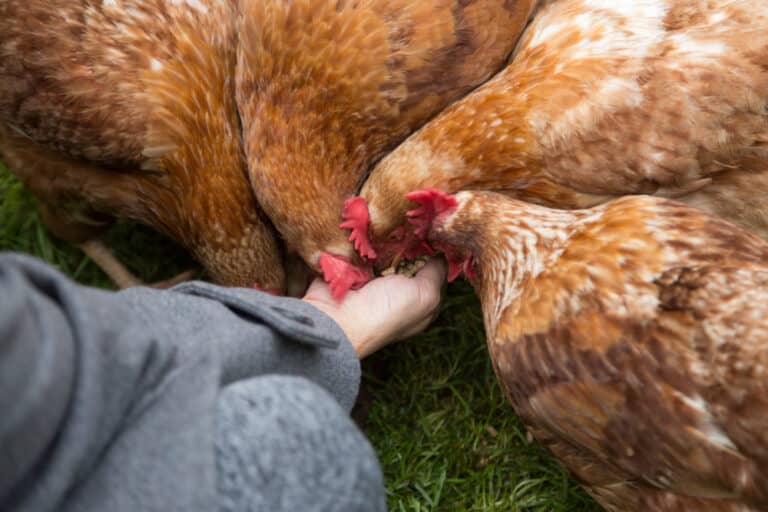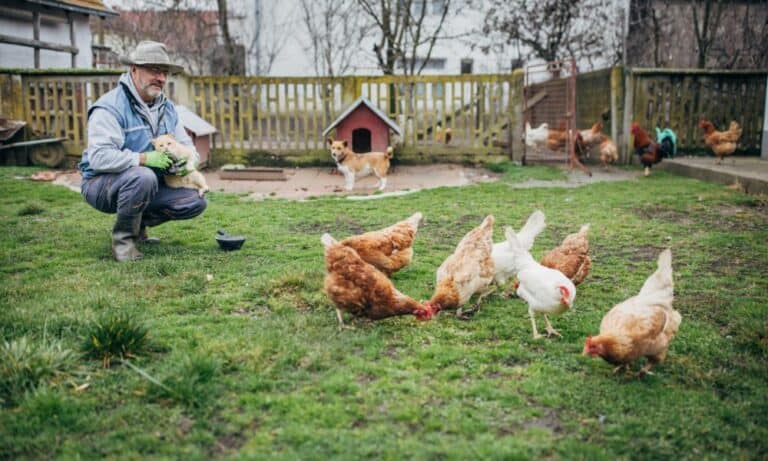Many people can’t understand the hen vs. chicken difference. Basically, every hen can be a chicken, but not all chickens are hens. Even though it sounds confusing, it is actually pretty simple to differentiate between these two terms.
You can use the expression chickens for both females and males, regardless of their age and commercial use. On the other hand, the term hen applies only to female chickens over one year of age used solely for egg production. Let’s check the primary differences between the two.
Hen vs. Chicken (Chart) |
||
| Trait | Chicken | Hen |
| Name | Type of fowl | Adult chickens kept for egg laying |
| Age | Any age | Mature, at least one-year-old female chickens or those laying their first eggs |
| Size | Mostly more sizable than hens | Mostly smaller than average chickens |
| Height | 20 to 30 inches (51 – 76 cm) | 20 to 25 inches (51 – 63.5 cm) |
| Weight | 7 to 10 pounds (3.2 – 4.5 kg) | 4 to 8 pounds (1.8 – 3.6 kg) |
| Gender | Males and females | Only females |
| Lifespan | 5 to 10 years | 5 to 10 years |
| Egg laying | Some females | Yes |
| Care requirements | Moderate | Moderate |
| Trainability | Food driven | Food driven |
| Family-friendly | Some breeds | Some breeds |
| Pet-friendly | Some breeds | Some breeds |
| Commercial use | Eggs and meat | Breeding and egg laying |
What Are Hens?
There are two views on when a chicken becomes a hen. In general, it happens when they turn one year old, regardless of the breed. On the other hand, there is an attitude in the egg-laying industry that the term hens should be used after chickens laying their first egg and becoming attractive to roosters.
Nowadays, hens’ primary purpose is egg production. Heritage hens start laying at 5 to 8 months old and keep producing eggs by their third to sixth year. On the other hand, hybrid hens start earlier, from 16 to 24 weeks, and lay eggs only for one to three years.
Hens lay through their first year of life until the first molt, when a pause period starts. You can expect them to start laying eggs again when their feathers regrow. After that, healthy hens keep producing eggs for a few years, but the precise duration depends on the breed and its specific physical traits.
Interestingly, hens hatched in winter start laying eggs later than those born in the summer. Depending on the breed, some lay one egg daily, while others produce only one egg in two days. However, hens may skip laying for a day or two without a particular reason.
As for the number of eggs, hens increase egg production while getting older. After reaching its peak, laying slowly decrease, typically after two to four years, but it depends on the inherited genes and the hen’s health.
Age
Based on two opposite theories, hens are chickens older than a year or after they start laying eggs. However, you can determine chickens’ maturity by checking their breast bone. Chickens are immature as long as that bone is still soft.
Personality
Mother hens are protective, sometimes overprotective, and can be aggressive when judging that their chicks are endangered. Even though they protect their chicks, they also give them enough space to explore and gain independence on time.
Laying hens
In this group, you can put all hens with the primary purpose of laying eggs. An average hen can lay 50 to 300+ eggs annually or 1 to 6 days weekly, depending on the breed. These hens require a cozy, stress-free environment, a specific diet, and comfortable nesting boxes.
Broody hens
You can treat broody hens as a different type, but they are only chickens with expressed maternal instincts. This psychological condition appears in some females with the only intention of laying and sitting on eggs until they hatch.
Be prepared that some breeds are more prone to broodiness, so you can take advantage of that if you keep chickens with a preliminary plan to get new chicks. Otherwise, you should stop this behavior on time to prevent health issues and excessive aggression towards other hens.
Cornish hens
Cornish hens (Cornish game hens) are chickens but different from real hens. This English chicken breed lives only until reaching a weight of 1 to 2 pounds (454 – 907 g) because they are raised exclusively for meat.
Most chickens in supermarkets are labeled that way, although they are common meat breeds, not the actual Cornish hen breed.
What Are Chickens?
Chicken (Gallus Gallus domesticus) is a non-gender-specific term for common domestic fowl. They are the Red and Grey Jungle chickens’ subspecies native to Asia and India.
It is believed that first chickens were domesticated for cockfighting, while ancient Greeks were those who started treating them as a food source. The ancient Egyptians used hens to hatch eggs.
Nowadays, you can recognize chickens bred for egg and meat production and dual-purpose breeds that are an excellent source of both. However, people often keep these intelligent and playful birds as pets, particularly attractive bantam breeds.
Age
There are no age or gender restrictions for chickens, and you can use this term for fowl from birth to the end of their lives. Chicks are the juvenile chicken offspring, followed by ‘teenagers’ – pullets and cockerels. Finally, mature chickens are referred to as hens and roosters.
You can also recognize capons, immature caponized (surgically altered) roosters with removed testicles. The purpose of such a treatment is to reduce aggression in males. In the past, it was a standard procedure in chickens bred for delicacy meat, but it was mainly abandoned because of procedure cost and high risks to chickens’ life.
Personality
Nowadays, chickens commonly live in confined spaces with only one purpose, to produce as many eggs and/or meat as possible. They rarely live more than two years and get slaughtered as soon as their production peak ends.
Therefore, no one cares about their personalities, which is a pity. Chickens are friendly, intelligent, fun, and curious creatures prepared to play. Only pet chickens can develop their full potential while living with children and other pets.
Purpose
Chickens are an excellent option for farmers and smallholding owners, plus some homeowners enjoy keeping attractive breeds in their yards. You can keep them for eggs, meat, or as pets. If you plan to get chicks, it is necessary to provide at least one rooster per approximately eight to ten hens.
Hens vs. Chickens
As I have already mentioned, there are no differences between chickens and hens because all hens are chickens. However, it is not the other way around. Unlike the term hens referring to mature egg-laying females, chicken is a common name for all fowls, regardless of age and gender.
Age
The term chickens is a collective name for fowl regardless of their age that includes:
- Chicks – From birth to 12 weeks
- Pullets – Young females (from 12 to 52 weeks old)
- Cockerels – Young males (from 12 to 52 weeks)
- Hens – Female chickens after laying their first egg
- Roosters – Male chickens old over a year
Besides these standard terms, you can find a few more in everyday use, like the following:
- Peeps – A term for chicks in general.
- Chooks – A synonym for chickens typically used in Australia and New Zealand.
- Cocks – A synonym for roosters.
- Started pullets or POL pullets – Pullets very close to beginning egg-laying.
- Straight run – A mix of purchased female and male chicks.
Gender
The primary difference between chickens and hens is in gender. While chickens are either females or males, hens are exclusively females. You can always use specific terms describing chickens’ age in more detail. However, it is often unnecessary unless it is vital to emphasize their gender and purpose.
Size and appearance
Despite of chicken breed, you can differentiate between chicken types based on their sizes and appearances. For instance, hens are typically less sizable than male chickens and those bred for meat production, regardless the gender.
Unlike roosters, hens rarely have pronounced gender characteristics, like combs and waddles. However, it is not impossible and depends on the breed. Besides, their muscle mass is less expressed, and they often look more fluffy because of more neck and chest feathering.
Ability to lay eggs
A primary difference between chickens and hens is their ability to lay infertile eggs for consumption and fertilized eggs for chick hatching. Hens are always egg layers, but some chickens can do it, and others don’t have this ability. Even mature female chickens are not always hens since they can be bred for meat.
Commercial use
Chickens can have a dual purpose, unlike hens exclusively used for laying eggs and breeding chicks. So, you can keep meat-type chickens for eggs or meat, sometimes even for feather production. Those kept for meat are more sizable and muscular than hens.
Summary
As you can see, chickens and hens are sometimes synonyms, and you can use the name chicken for this poultry type in general. However, the word hen has a specific meaning and refers to mature females with the primary purpose of laying eggs and breeding. It is not crucial when buying chicken meat in the store, but you need to know to differentiate them when planning to go into farming.

